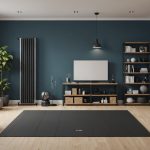Understanding Space Constraints in Home Fitness
In the context of home fitness, UK residents often face unique space constraints due to the architectural specifics of their homes. Many UK homes are characterized by smaller rooms and limited floor space, which can pose a challenge when attempting to set up a fitness area. As a result, it is crucial to design workouts that fit seamlessly into these confined spaces.
When planning a fitness regime, the goal is to ensure exercises are compact while still being effective. Compact routines such as bodyweight exercises, yoga, or resistance band workouts are ideal for small areas. They require minimal equipment and can be done almost anywhere, making them perfect for those dealing with space constraints.
In parallel : Transform Your Work-from-Home Setup: Essential Tips for UK Adults to Enhance Posture and Boost Comfort
Despite limited space, embracing these compact home fitness routines offers several advantages. They encourage creativity in workout planning and can reduce setup time and expenses associated with larger equipment. Additionally, workouts designed for smaller spaces can be equally challenging and beneficial as those requiring more room.
Beyond practicality, these adaptable routines empower UK residents to maintain an active lifestyle, regardless of their living situation. By embracing innovative workout methods, individuals can overcome spatial limitations and build a healthier future at home.
Also to read : Boost Your UK Diet: Creative Ways to Add More Whole Foods to Your Plate
Effective Compact Workout Plans
In today’s fast-paced world, finding time for regular workouts can be challenging. However, compact workout plans offer a solution that fits seamlessly into busier schedules. By incorporating efficient exercises, individuals can achieve full-body workouts in small spaces, making home workouts more accessible and less daunting.
Bodyweight exercises are the cornerstone of these efficient routines. Their effectiveness lies in their ability to engage multiple muscle groups without the need for equipment. Classic movements such as squats, push-ups, and planks not only build strength but also improve core stability and endurance. Because of their versatility, they can be performed in limited space, such as a living room or even a bedroom.
High-Intensity Interval Training (HIIT) is another component of an effective compact workout plan. Short, intense bursts of activity, followed by brief rest periods, increase cardiovascular fitness and aid in weight loss. A typical HIIT session could include sprints, burpees, or jumping jacks combined into rapid cycles. These sessions are particularly beneficial as they can be executed in as little as 15-30 minutes, offering a thorough workout in a time-efficient package.
By utilizing the elements of compact workout plans, individuals can maintain fitness goals even amid tight schedules.
Space-Efficient Equipment Recommendations
When it comes to home fitness equipment, choosing multi-functional pieces is essential. This not only maximizes utility but also saves precious space. One standout option is the adjustable dumbbell set, which caters to multiple fitness levels with just one piece of equipment. Similarly, a resistance band set offers a versatile solution for strength training, easily replacing bulky weights.
For those prioritizing space, consider compact alternatives to traditional gym gear. A foldable treadmill or a mini stationary bike, for instance, allows cardiovascular training without the room-consuming footprint of their larger counterparts. Additionally, a suspension trainer can be anchored to a door, facilitating a full-body workout with minimal gear.
Budget-savvy fitness enthusiasts can explore affordable options without compromising on quality. Websites specializing in workout gear often feature discounts on bundles, ensuring you get more for less. Another tip is to visit second-hand stores or online marketplaces, where gently used equipment is sold at a fraction of its original cost.
Key considerations such as versatility, space constraints, and affordability ensure that building a home gym is achievable for everyone. By selecting the right space-efficient gear, you can maintain an effective fitness regime from the comfort of your home.
Adapting Exercises for Limited Areas
Making the most out of limited space workouts is achievable by incorporating several strategies to keep your routines effective and engaging. There are techniques to turn standard exercises into adaptable exercises suitable for small areas.
Begin by modifying movements such as squats or lunges; short steppers or knee lifts can replace traditional versions without requiring extensive room to manoeuvre. Resistance bands are versatile tools that take up minimal space yet expand your exercise options significantly.
Utilise furniture creatively to enhance your small area fitness regime. A sturdy chair or a countertop can support tricep dips, incline push-ups, or even step-up exercises, thereby diversifying your routine.
Maintain workout variety by rotating exercises and integrating bodyweight routines like planks or mountain climbers. This prevents monotony and continually engages different muscle groups.
For additional adaptable exercises, try yoga or Pilates as they inherently require less room. Employ inventive strategies, and monitor your progress using fitness apps designed for small space regimes, helping keep track of achievements and goals achieved. This approach not only ensures you enjoy a diverse workout experience but also maximises the efficacy of your limited space workouts.
Maintaining Motivation in Small Spaces
Navigating workout motivation in small areas can be a creative challenge but a rewarding one. It’s crucial to evolve fitness routines that embrace limited space without sacrificing effectiveness. Small spaces can drive you to rethink your approach, ensuring your exercises are compact yet efficient.
Tips for Enjoyable Workouts
First, make your fitness routines enjoyable by incorporating exercises that can be done in limited space, such as yoga or bodyweight circuits. Focus on activities that don’t require much room, like planks or lunges, which can be both engaging and effective.
Setting Realistic Fitness Goals
Secondly, set realistic fitness goals. Consider the constraints of your living area and tailor your objectives accordingly. Instead of lofty targets, aim for manageable milestones that give you a sense of achievement within your environment.
Incorporating Social Elements
Adding a social element can boost your motivation significantly. Whether it’s through virtual classes or shared online challenges with friends, having a social circle can add a sense of community to your workout regime. This can be vital in maintaining enthusiasm, offering accountability, and making workouts a fun, shared experience.
Empower your fitness journey by turning your space limitations into a driving force for innovation and creativity in your exercise routine.
Scheduling Workouts Into Daily Routines
Incorporating workout scheduling into your daily fitness routines can be challenging yet rewarding. For many, the key to success lies in effective time management. By prioritising fitness, you not only enhance your physical health but also boost your mental wellbeing. Here are some strategies to balance exercise with a packed schedule:
-
Morning Sessions: Begin your day with physical activity. It kickstarts your energy, enhancing productivity throughout the day.
-
Lunchtime Workouts: If mornings are not an option, utilise lunch breaks for a quick fitness session. A short walk or gym visit can reinvigorate your afternoon.
-
Evening Routines: For those with more flexibility in the evening, plan workouts when you’re naturally less busy. Establishing this consistency optimises your time and ensures commitment.
The frequency of workouts should adapt to personal lifestyles and obligations. Opt for several shorter sessions weekly if time is constrained, or choose intense, less frequent routines if that suits better. The main goal is consistency—what works is what fits into your lifestyle seamlessly. Leveraging these tactics in your daily fitness routines ensures sustainability and maximises results over time.











